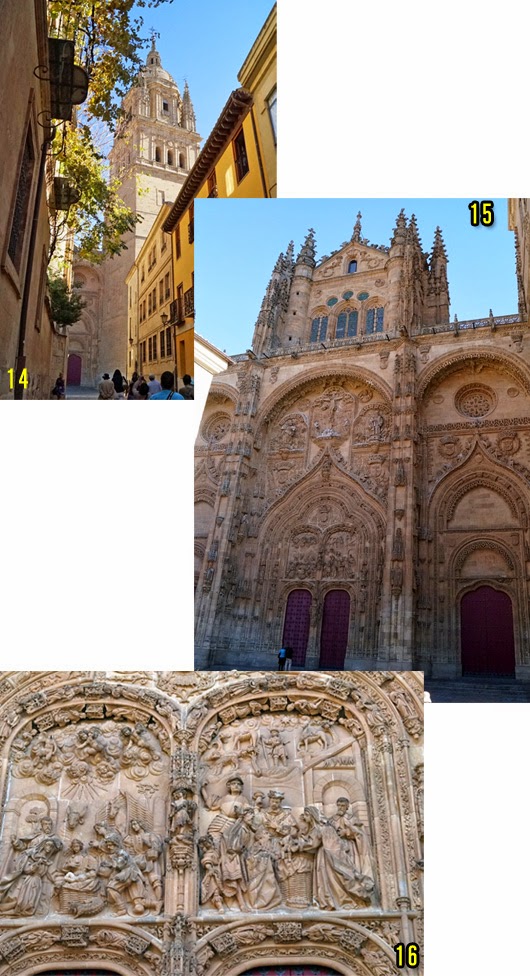< 1. ??? >
Today, I introduce
Basilica de la Sagrada Familia and Barcelona.
Barcelona was the
first visit place of our trip.
I was shocked by
architect Gaudi’s thought and idea concerning the church.
今日はバルセロナと聖家族教会を紹介します。
バルセロナは旅行の最初の訪問地でした。
私は建築家ガウディの教会への想いと発想に衝撃を受けました。
< 2. Cityscape of
Barcelona >
< 2. バルセロナの街並み >
Upper two photos: Views of the Mediterranean Sea and Basilica
de la Sagrada Familia from Montjuic.
Left lower photo: There is a
balcony in the building without exception, and the wall surface is decorated
beautifully, and the cityscape is orderly and beautiful.
It stood out everywhere that a flag was
hanging on a balcony in hope of Catalonia independence.
Right lower photo: The decoration of a building in the right
side of Basilica de la Sagrada Familia is beautiful.
上2枚の写真: モンジュイックの丘から地中海と聖家族教会を臨む。
左下の写真: 建物には例外なくバルコニーがあり、壁面は美しく飾られ、街並みは整然とし美しい。
一つのバルコニーにカタルーニャ独立を願って旗が掛けられ、至るところで目につく。
右下の写真: 聖家族教会の右の建物の装飾が美しい。
< 3. Palau de la Musica Catalana. It is a masterpiece of
Modernismo. >
< 3. カタルーニャ音楽堂、モデルニスモの代表作 >
This building that was completed in 1908
is a world heritage with a masterpiece of Domenech.
It was decorated by the mosaic tile and
the sculpture of the floral design, and I feel Islam style in it.
1908年に完成したドメネクの代表作で世界遺産。
花模様のモザイクタイルや彫刻が施されていてイスラム様式を感じる。
Fetal activity of Barcelona
Modernismo was the art style similar to
art nouveau of France, and was prevalent centering around Balcelona in the
early 20th century from the end of the 19th century.
In 1898, Spain lost in war with America,
and therefore a cultural movement (self-government movement) for the mother
country reproduction by the intellectual gained steam.
On the other hand, in
Barcelona of the early 20th century, the industrialization developed and it was
prosperous.
Artists aimed at the
ecdysis from the industrial standardization, in the theme of nature, and created
the novel style that assimilated Islam style of Medieval Spain.
This advocate was
Domenech mentioned above and Gaudi, and Picasso, Miro and Dali who participated
actively at later spent youth in this Barcelona.
バルセロナの胎動
モデルニスモはバルセロナを中心に19世紀末から20世紀初頭に流行した、フランスのアール・ヌーボーと類似した芸術様式。
1898年、スペインは米国との戦争で敗れ、その為、知識人による祖国再生の文化運動(自治運動)が盛り上がった。
一方、20世紀初頭のバルセロナは工業化が進展し繁栄していた。
芸術家達は工業規格化の脱皮を目指し、自然を題材にし、スペイン中世のイスラム様式を取り入れた斬新な作風を生んだ。
この唱道者が先述のドメネクやガウディであり、後に活躍するピカソ、ミロ、ダリはこのバルセロナで青春を過ごした。
< 4. Basilica de la
Sagrada Familia, The Nativity facade >
< 4. 聖家族教会、生誕のファサード >
The building of this church began in
1882, and Gaudi had charge of the construction from the next year to 1926 of
his death.
All construction costs are served by a
personal donation and it is under construction at present, and it is scheduled
to complete in 2026.
この教会は1882年に着工され、翌年からガウディは1926年(死去)まで建築を担当した。
建築費用はすべて個人の寄付によって賄われ、現在も工事中で、2026年に完成予定。
< 5. The Nativity facade, it is a theme of Jesus’ birth >
< 5. 生誕のファサード:イエスの生誕がテーマ >
Upper photo: The upper part
of the facade.
Central photo: We can see the coronation of Virgin Mary in
the top right corner, and the annunciation in the lower.
Lower photo: In upper part
of the entrance, Six angels play a musical instrument.
All these sculpture have movement and
three-dimensional form, and a lot of the ornament is used without a gap.
These exceed all facades’ sculptures of
various churches of Iberia that I had looked at until now.
However, I thought it was slightly
excessively, and have begun to doubt the innovativeness of Gaudi.
上の写真: ファサード上部。
中央の写真: 右上に聖母マリアの戴冠、その下に受胎告知が見える。
下の写真: 入口の直ぐ上で、6人の天使が楽器を演奏している。
どれも動きのある立体的な彫刻で、さらに装飾が隙間無く施されている。
これは今まで見てきたイベリア各地の教会の彫刻を凌いでいる。
しかし私にはやや過剰に思え、ガウディの革新性に疑いを持ち始めた。
< 6. Inside the church >
< 6. 教会内部 >
However, when I went in
the church by one step, my chest became hot, and a tear fell.
In it, there was an
aspect that I did not look at until now.
First, light was overflowing.
It isn't the bright light or the golden
light, and a beam of light illuminating silent darkness.
It made me feel as if
man was held in God’s bosom by warm light surely.
ところが堂内に一歩足を踏み入れと、胸が熱くなり涙が出て来た。
今まで見たこともなかった光景がそこにはあった。
先ず、光りが溢れていました。
それは明るい照明とか黄金色とか、静寂の闇を照らす一筋の光りではない。
それは正に温かい光りによって神の懐に抱かれるような気にさせるのです。
< 7. The ceiling
looked up >
< 7. 見上げた天井 >
Furthermore, I admired the
technical idea of Gaudi.
It was that the pillar such as the tree
branching off had supported the ceiling.
First, I felt fear the ceiling fall with
broken pillar.
If using ferroconcrete
technology of those days, he shouldn't have to do such adventure.
さらに私はガウディの技術的発想に驚嘆した。
それは枝分かれした樹木のような柱が天井を支える構造でした。
始め、私はその柱が折れて崩れ落ちる恐怖を感じた。
当時の鉄筋コンクリート技術を使えば、このような冒険をしなくても良いはずでした。
< 8. The Chapel >
< 8. 礼拝堂 >
The handling of Jesus’
image was novel, but I felt fresh brightness and warmth.
イエス像の扱いは奇抜であるが、新鮮な明るさと温かみを感じた。
< 9. Passion Facade. >
< 9. 受難のファサード: イエスの受難がテーマ >
It is just opposite to the Nativity
facade.
Thus we began to visit this church at
16:00 and finished it at 16:50.
これはちょうど生誕のファサードの反対側にある。
こうして私達は教会の見学を16:00に始め、16:50に終えました。
Finally
I looked back on the
sightseeing of Spain and Portugal, and I tried to understand the idea of Gaudi.
The church of the Middle Ages started in
dusky room, and it progressed to gilded gorgeous decoration, and it utilized the
light of the stained glass before long.
However, Gaudi thought
that a chapel in that the believers pray and Mass is performed has to be a
place wrapped in warm light.
In addition, he thought that the room has
to overflow with life and trees.
He created the new church as a pious
believer.
On the other hand, after
all, there was the culture of Iberia in the undercurrent.
For example, it relates
back to the pillar like
a palm tree of Monsteiro dos Jeronimos (Lisbon).
It is also the vivid
mosaic tile of Park Guell and Palau de la Musica Catalana.
Excess decoration was
seen much in church’s facade of Portugal and Spain.
Islam and Christianity fuses, and
alternate current through the Mediterranean Sea and the Atlantic created the
various and flexible culture.
最後に
私はスペインとポルトガルの観光を振り返り、ガウディの発想を理解しようとした。
中世の教会は、薄暗い堂内から始まり、金ピカの華美な装飾へと進み、やがてステンドグラスの光りを生かすことになった。
しかしガウディは信者が祈りミサを行う礼拝堂は温かい光りに包まれた所であるべきだと考えた。
また彼は堂内が生命に溢れ、樹木が林立する空間であるべきだとした。
彼は敬虔な信者として新しい教会を創造した。
一方で、やはりイベリアの文化が底流にあった。
例えば、それはジェロニモス修道院(リスボン)の椰子の木を模した柱に通じる。
グエル公園やカタルーニャ音楽堂の鮮やかなモザイクタイルがそうです。
教会の過剰な装飾はポルトガルやスペインのファサードに多く見られた。
イスラム教とキリスト教の融合、地中海と大西洋による交流が多様で柔軟な文化を生んだのだろう。

































